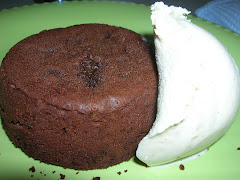Monday, June 22, 2009
Food, Inc.
Food, Inc. includes interviews of some of the greatest forward-thinking (or should I simply just say they use their brains?) pioneers in the local, organic, and real food movements. Interviews include the likes of my favorite, Michael Pollan, Virginia-based Polyface Farm owner Joel Salatin, and the well-known author of Fast Food Nation, Eric Schlosser.
Maybe this will spread the word and more people will finally understand the importance of scrutinizing where your food comes from. Here's hoping...
Thursday, June 18, 2009
Beauty comes to those who wait
But you know what?
It was totally worth it. And it didn't take much effort.
Think I'm sounding contradictory? Wait until I tell you I didn't knead the bread. Not once. Not at all.
 I really like my everyday bread, but I've been searching for the perfect at-home artisan loaf: an airy texture, a well-developed flavor, and a shattering crispy crust. Well this is it.
I really like my everyday bread, but I've been searching for the perfect at-home artisan loaf: an airy texture, a well-developed flavor, and a shattering crispy crust. Well this is it.Jim Lahey's no-knead bread is truly a gem. I was skeptical, alright, but the proof is right here.
Artisan Bread
courtesy of Sullivan St. Bakery
3 cups bread flour
1 1/2 cups water
1/4 teaspoon yeast
1 1/4 teaspoon salt
olive oil (for coating)
extra flour, wheat bran, or cornmeal (for dusting)
Mix all of the dry ingredients in a medium bowl. Add water and incorporate by hand or with a wooden spoon or spatula for 30 seconds to 1 minute. Lightly coat the inside of a second medium bowl with olive oil and place the dough in the bowl. Cover the bowl with plastic wrap and let the dough rest 12-18 hours at room temperature. (I let mine rest for about 20 hours!)
Remove the dough from the bowl and fold once or twice. (See the Minimalist's review to see the picture of the fold and also to see Bittman's review.) Let the dough rest 15 minutes in the bowl or on the work surface. Next, shape the dough into a ball. Generously coat a cotton towel with flour, wheat bran, or cornmeal; place the dough seam side down on the towel and dust with flour. Cover the dough with a cotton towel and let rise 1-2 hours at room temperature, until more than doubled in size. (Wait the full 2 hours-- you've already waited this long!)
Preheat oven to 450-500 degrees F. Place the pot in the oven at least 30 minutes prior to baking to preheat. Once the dough has more than doubled in volume, remove the pot from the oven and place the dough in the pot seam side up. Cover with the lid and bake 30 minutes. Then remove the lid and bake 15-30 minutes uncovered, until the loaf is nicely browned.
Notes: My dough stuck pretty horribly to the towel, so I think next time I'm going to well flour parchment paper and place the dough in the parchment and then surround with a towel for warmth. I baked my bread in my Romertopf clay pot, which required 30 minutes of soaking beforehand. With a gas oven you also need to heat the pot slowly. Over a period of 30 minutes slowly increase the oven temperature so that the clay pot does not crack from too drastic a temperature change. And don't worry about the dough sticking to the ungreased pot. There's not a chance it will after baked.  I haven't had bread with this crispy a crust since I lived in France; a crunch that battles the strength of your jaw muscles. My bread knife was hardly suitable to crack through once it came out of the oven. (Yea yea, I couldn't wait for it to cool. So sue me...) But once you break through slightly it shatters like an airy crumb should and reveals a light, developed bread within. And the smell. Heavenly. This is a whole new realm of bread.
I haven't had bread with this crispy a crust since I lived in France; a crunch that battles the strength of your jaw muscles. My bread knife was hardly suitable to crack through once it came out of the oven. (Yea yea, I couldn't wait for it to cool. So sue me...) But once you break through slightly it shatters like an airy crumb should and reveals a light, developed bread within. And the smell. Heavenly. This is a whole new realm of bread. 
Wednesday, June 10, 2009
Prepare yourself for a rant...
Okay, are you truly that gullible and, well, stupid?
Allow me to back up and explain what has me so revved up. A good friend of mine at work shares my views regarding whole, natural foods and the idiocy of constantly 'dieting' on highly-sugared 'fat-free' health food. I can't mock those irreconcilable words enough.
I'll preface by saying that the woman at work around whom this story revolves once posited she couldn't have orange juice because it had too many calories. Wha-at?! Ah yes, I once heard the tail of the woman so fat she couldn't move from her bed. The culprit? OJ.
So back to my story. This woman--let's call her Alice-- remarked that she needed to have breakfast. My friend immediately offered up the Kashi GoLean Crunch she keeps at her desk. Another offered up Special K. So Alice, being the prudent food connoisseur that she is, immediately compared the nutrition panel, not even glancing at the actual ingredients. She quickly remarked, 'OH I can't have the Kashi! It has sooo many more calories and, oh, 3 grams of fat!' My friend told her that the Kashi contains more vitamins and minerals. Alice said, 'Oh I don't care about those.' !!!!!! You are dieting and trying to eat better and you don't care about this little thing commonly referred to as nutrition?!
I hate, hate, hate how people look at the nutrition panel for health information. How does that tell you what you're actually eating? It's poor nomenclature. It should be reworded. Panel indicating the lowest caloric and fat content possible through manipulation and arrangements of ingredients that substitute for real, whole foods in order to fool you into purchasing this food and believing it to be a healthy alternative, comes to mind. It has a good ring to it, don't you think?
My friend then took both boxes to compare what really matters-- the actual ingredients. She told Alice that Kashi will have more calories and fat because it has tons of fiber and hearty ingredients to keep you full much longer. So here's where the story really gets me riled up. My friend saw the horrible ingredients in Special K, the number one culprit being high fructose corn syrup. She told Alice this and she said, and I quote, 'But you saw the commercials. It's fine in moderation.'
Breathe, Tiffany, breathe. Do you ever see commercials for oranges or tomatoes or apples claiming that they are healthy? No, no you don't because their nutrition is not questionable. You only have propaganda pushed out by Big Corn, you ignorant simpleton. And she quoted directly from the commercial!! I didn't think those commercials were effective at all because I wrongly assumed people were smart enough to see through such transparent propaganda.
*So then my friend points out that it's full of preservatives. Alice's reaction? 'What? Preservatives? Where? I don't see that listed!'
You actually think the ingredient panel will list preservatives under such name?! My friend said, 'Um, you see all of these words you don't know? Those are the preservatives...'
Shocker. Preservatives aren't listed as preservatives on the label.
And that, my friends, is how the food makers get away with making 'foodlike substances'.
Sunday, June 7, 2009
Neophilia
 Swiss chard. I have never seen such a 'pretty' green. Stalks vibrantly shaded in reds and yellows. Also another item I had been meaning to experiment with. So here goes...
Swiss chard. I have never seen such a 'pretty' green. Stalks vibrantly shaded in reds and yellows. Also another item I had been meaning to experiment with. So here goes...










